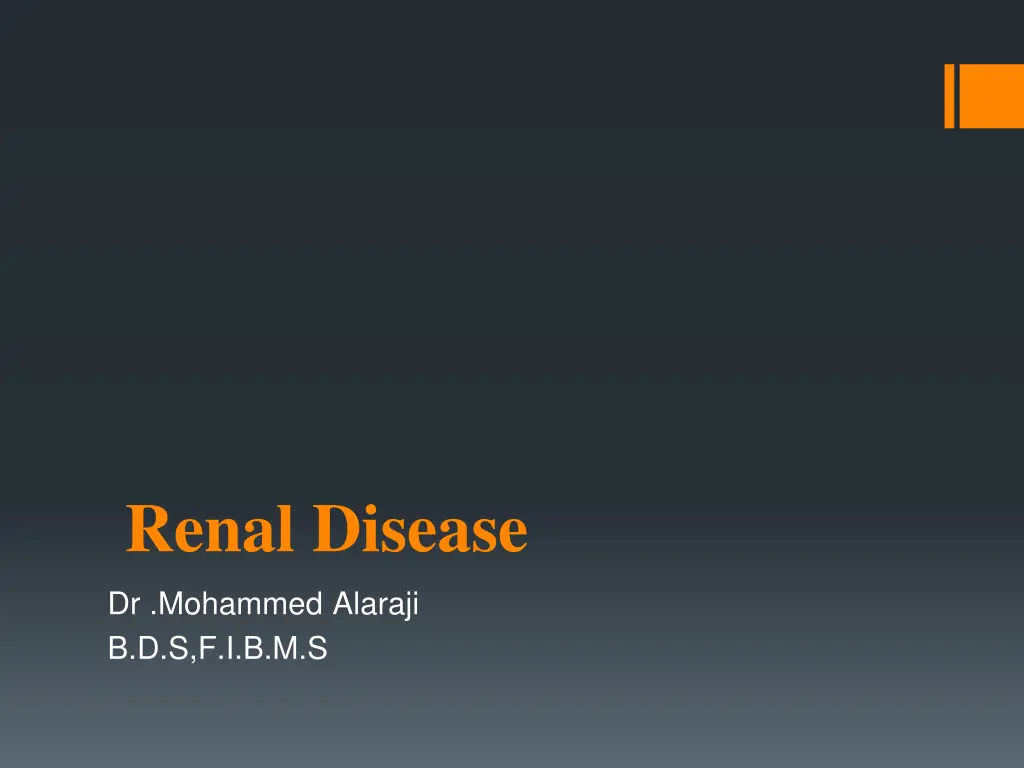
Dental Considerations for Renal Diseases in Dentistry
Learn about the impact of renal diseases like acute glomerulonephritis, chronic glomerulonephritis, and renal failure on dental procedures. Discover important preventive measures and surgical considerations when treating patients with renal conditions.
Download Presentation

Please find below an Image/Link to download the presentation.
The content on the website is provided AS IS for your information and personal use only. It may not be sold, licensed, or shared on other websites without obtaining consent from the author. If you encounter any issues during the download, it is possible that the publisher has removed the file from their server.
You are allowed to download the files provided on this website for personal or commercial use, subject to the condition that they are used lawfully. All files are the property of their respective owners.
The content on the website is provided AS IS for your information and personal use only. It may not be sold, licensed, or shared on other websites without obtaining consent from the author.
E N D
Presentation Transcript
Renal Disease Dr .Mohammed Alaraji B.D.S,F.I.B.M.S
The renal diseases that are of particular interest to the dentist are: acute glomerulonephritis, chronic glomerulonephritis, and renal failure.
Acute Glomerulonephritis This disease is characterized by acute, diffused inflammation of the glomeruli. It is more common in young people and it is caused by group A -hemolytic Streptococcus, especially after upper respiratory infection (tonsillitis, otitis, pharyngitis). This is a severe condition and no surgical procedure is allowed in the oral cavity without consultation with the patient s treating physician. If deemed absolutely necessary, the surgical procedure must be performed in the hospital.
Chronic Glomerulonephritis This disease presents without symptoms in the initial stages, the findings being proteinuria and the presence of hemorrhagic casts in the urine. Hypertension, headache, anemia, and polyuria are also observed. This Disease develops slowly and eventually the renal parenchyma of both kidneys is destroyed. The Patients with this disease may undergo surgery without prophylactic antibiotics. The following, however, are considered necessary: I. Consultation with the patient s treating physician II. Constant monitoring of blood pressure before and during the surgical procedure, because these patients are usually hypertensive.
Chronic Renal Failure This is a clinical syndrome characterized by permanent kidney damage, resulting in impaired glomerular and tubular function. Patients with chronic renal failure develop anemia, and, in advanced cases, hemorrhagic diatheses (thrombocytopenia in 50% of cases), as well as other metabolic disturbances. The most common causes of the disease are glomerulonephritis, diabetes mellitus.
When a surgical procedure is to be performed on the patient, the following preventive measures are necessary: 1. Consultation with the patient s treating nephrologist. 2. In cases of severe anemia, the hematocrit must be at acceptable levels. 3. Preventive measures to avoid extensive hemorrhage due to hemorrhagic diatheses. 4. 5. Monitor blood pressure closely. Aggressively manage orofacial infections with culture and sensitivity tests and antibiotics 6. Local measures to control bleeding by placing gelatin sponge in the socket, as well as sutures for optimal healing of the wound. 7. Use of minimal amounts of vasoconstrictors, because hypertension is usually observed in chronic renal failure. 8. Use of minimal amounts of local anesthetics in order to avoid toxicity. 9. Avoidance of any dental procedure on the day of hemodialysis.
RECEIVING HEMODIALYSIS 1. Same as conservative care recommendations. 2. Beware of concerns of arteriovenous shunt. 3. Consult with physician about risk for infective endarteritis or endocarditis. 4. Avoid blood pressure cuff and IV medications in arm with shunt. 5. Avoid dental care on day of treatment (especially within fi rst 6 hours afterward); best to treat on day after. 6. Consider antimicrobial prophylaxis. 7. Consider corticosteroid supplementation as indicated. 8. Assess status of liver function and presence of opportunistic infection in these patients because of increased risk for carrier state of hepatitis B and C viruses and human immunodeficiency virus (HIV)
AIDS , hepatitis B and C are infectious diseases that are worldwide health problems and are found in all social classes. Therefore, both the dentist and the patient need to be protected against transmission. The medical history of the patient is significant and precautionary measures must be taken especially where high-risk groups are involved; namely, patients who undergo hemodialysis, drug-users, patients who have blood transfusions on a regular basis, and people who come from countries where the incidence and prevalence of these infectious diseases is high (Africa, Asia, etc.).
The risk of transmission of an infectious disease from one patient to another basically involves the use of infected instruments during surgical procedures. The dentist is also at risk of infection after coming into contact with a carrier of the disease. Transmission of infectious disease occurs after direct contact with blood and saliva or after accidental puncture by an infected needle or other sharp dental instrument.
If the dentist establishes that the patient about to undergo surgery is a carrier of one the aforementioned viruses, rigid precautionary measures are deemed necessary. These include: 1. Programming the surgical procedure as the last appointment of the day. 2. Using two pairs of disposable gloves. Gloves protect the patient as well as the dentist and should be discarded immediately after use. 3. Special protective glasses and disposable surgical mask. 4. Special protective surgical gown and cap covering scalp hair. 5. Disposable needles. Great care should be taken during their use, in order to avoid accidental puncture. Discarding of surgical blades and disposable needles in a rigid sharps container, which is sealed when full and is removed from the dental office should also be a standard. 6. Collecting all (saliva ejectors, plastic cups, gloves, masks, gauze, etc.) in a tough nylon bag. 7. After the surgical procedure, disinfection of certain objects with a virus-active disinfectant according to the local hygiene guidelines (exposed parts of the dental chair, the dentist s stool, spittoon, etc.). 8. Sterilization of all instruments that were used in an autoclave, after they are cleaned and disinfected manually.






















